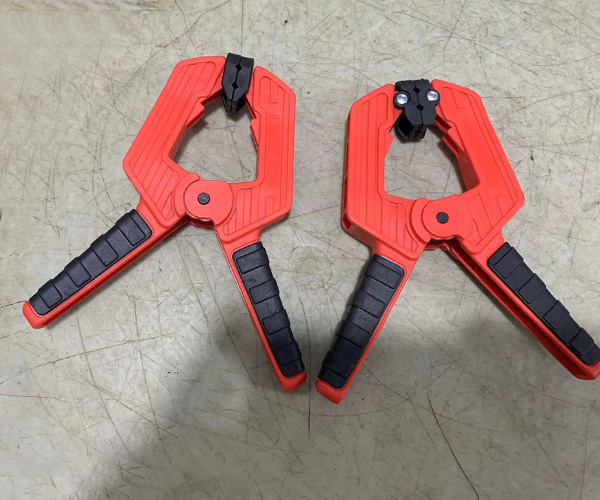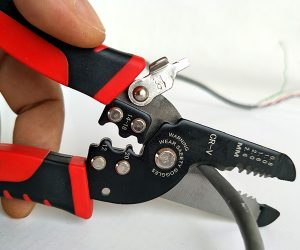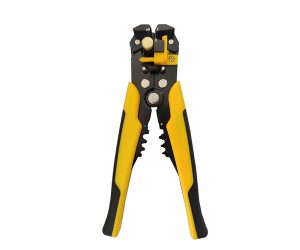Spring clamps are a versatile tool used across a variety of industries, offering quick and secure holding power. But what exactly are they used for, and why should you consider incorporating them into your projects? In this article, we’ll explore the many functions and uses of spring clamps, as well as tips for choosing the right one for your needs. Get ready, because by the end of this article, you’ll know exactly how to make the most of these simple but powerful tools.
1. What is a Spring Clamp?
When it comes to tools, sometimes the simplest solutions are the best. A spring clamp is a mechanical device that holds materials tightly together using spring tension. It’s one of the most widely used clamping tools in woodworking, automotive, and DIY tasks. But what makes a spring clamp stand out? It’s all about the simplicity of its design. The clamp features two arms with a spring mechanism that automatically holds objects when they are inserted. This means you don’t need to manually tighten it, saving you time and effort.
What’s the real story? These clamps come in various sizes and materials, from small plastic models to larger, more robust metal versions. Whether you’re holding a small piece of wood for gluing or securing parts in an automotive repair, these clamps offer the flexibility and strength you need.
Spring clamps are incredibly handy due to their lightweight and easy-to-use design. They’re portable and can be quickly applied, making them ideal for tasks that require temporary holding of materials. For example, when woodworking, you can use a spring clamp to keep pieces together while the glue dries, ensuring a secure bond every time. But here’s the kicker: they’re also useful in automotive work, holding car parts or components while repairs are being made. The applications are practically endless, making them an essential tool in many toolkits.
| Feature | Small Spring Clamp | Large Spring Clamp | Heavy-Duty Clamp |
|---|---|---|---|
| Size | 4 inches | 6 inches | 8 inches |
| Material | Plastic | Metal | Steel |
| Grip Type | Rubber-coated | Rubber-coated | Heavy-duty rubber |
| Maximum Load | Light-duty | Medium-duty | Heavy-duty |
| Best Use | Crafts, DIY | Woodworking, Car repairs | Industrial, automotive |
2. How Do Spring Clamps Work?
Spring clamps operate on a simple but effective mechanism: the spring tension holds objects in place once the clamp is applied. Ready for the good part? It’s all about that tension. The clamp has two arms connected by a spring, which applies constant force. When you place the clamp on an object, the spring tension automatically adjusts to hold the object securely without requiring additional force or manual tightening.
This simplicity is why spring clamps are so popular. You simply squeeze the handles together to open the clamp, position it over the object you want to hold, and release the handles. The spring then closes the clamp around the object. For more precision, many spring clamps come with adjustable arms, allowing you to apply different levels of tension depending on the material or task at hand.
But wait, there’s more! The design of a spring clamp is highly versatile, enabling it to be used in numerous situations. Whether you’re in need of a quick fix or want to apply a strong clamping force, spring clamps provide an effortless solution. The mechanism makes them incredibly easy to use, even for those who aren’t tool experts. From basic household repairs to professional tasks, spring clamps provide a reliable, quick, and simple way to hold materials in place.
| Spring Clamp Type | Tension Strength | Material Compatibility | Ideal For |
|---|---|---|---|
| Standard | Low to Medium | Wood, Plastic | DIY projects |
| Heavy-Duty | High | Metal, Wood, Fabric | Automotive repairs |
| Mini | Low | Paper, Thin materials | Craft projects |
3. What Are the Common Uses of Spring Clamps?
Spring clamps aren’t just for one thing — they’re incredibly versatile. Whether you’re a professional carpenter, a DIY enthusiast, or a hobbyist, spring clamps are invaluable tools. What’s the real story? They’re most often used for quick clamping, whether it’s for holding materials in place temporarily or applying consistent pressure during a drying or setting process.
For instance, in woodworking, spring clamps are perfect for holding wood together while glue dries. Instead of waiting for the glue to naturally bond, the spring clamp applies even pressure, speeding up the process. This is particularly useful when working on multiple pieces of wood at once. It ensures a solid bond every time.
Ready for the good part? Spring clamps also shine in automotive repairs. These clamps are perfect for holding parts in place during welding, painting, or repairs. Their spring-loaded design allows them to hold components securely, without requiring you to constantly adjust or tighten them. This means you can get the job done faster and more efficiently.
Spring clamps also find their place in other areas like arts and crafts, home improvement, and even in light industrial work. Whether you’re hanging a painting, securing fabric, or organizing cables, spring clamps are up to the task.
| Use Case | Material Held | Clamping Force | Application Type |
|---|---|---|---|
| Woodworking | Wood, Plywood | Medium | Temporary holding |
| Automotive | Metal, Plastic | High | Repairs, painting |
| DIY Projects | Fabric, Wood, Paper | Light to Medium | Arts, Crafts |
| Home Improvement | Wood, Plastic | Light to Medium | Installing hardware |

4. Why Are Spring Clamps Ideal for Quick Clamping?
What makes spring clamps so special for quick clamping? It all boils down to their speed and ease of use. When you need a tool that can be applied quickly and securely, spring clamps fit the bill perfectly. They’re designed to be quick-release, meaning they’re easy to apply, hold the materials tightly, and can be removed in seconds.
But here’s the kicker: They allow you to focus on other parts of your project while they do the hard work. When working on large-scale projects or trying to fit multiple components together, the spring clamp can hold one piece in place while you focus on the rest. Whether you’re aligning parts or holding materials in place, you’ll appreciate how fast and effective they are.
Another reason spring clamps are ideal for quick clamping is their portability. Most spring clamps are lightweight and easy to carry. This means you can bring them with you on-site or to the job without the hassle of bulky tools. The compact design is perfect for professionals who need to travel between jobs or for DIY enthusiasts who need a quick fix around the house.
| Clamping Feature | Speed of Application | Ease of Use | Portability |
|---|---|---|---|
| Spring Clamps | Fast | Very easy | Compact, lightweight |
| Bar Clamps | Moderate | Medium | Larger, heavier |
| C-Clamps | Slow | Requires adjustment | Large, bulky |
5. What Are the Benefits of Using a Spring Clamp?
Spring clamps offer a multitude of benefits that make them a must-have tool in any toolbox. They are incredibly durable, cost-effective, and versatile. But what really sets them apart is how easy they are to use. Ready for the good part? Unlike other types of clamps that require tools or additional adjustments, spring clamps are incredibly straightforward. The spring mechanism makes it easy to apply pressure, so you don’t need to worry about tightening or loosening screws.
In addition to being user-friendly, spring clamps are also extremely durable. The majority of these clamps are made from high-quality metal or reinforced plastic, ensuring they can withstand repetitive use without losing their effectiveness. Plus, the rubberized handles offer a firm and comfortable grip, preventing slippage during use.
But wait, there’s more! They’re incredibly affordable, making them accessible for anyone, regardless of budget. Whether you’re a hobbyist or a professional, spring clamps are an economical option for clamping. With so many uses and a low price point, these clamps deliver great value. They’re small, light, and easy to store, making them a great addition to your tool collection.
| Feature | Benefit | Ideal Use |
|---|---|---|
| Durability | Long-lasting | Frequent use |
| Versatility | Multi-material clamping | Various industries |
| Ease of Use | Quick application | DIY, Professional |
| Portability | Easy to carry | Field work, small spaces |
6. What Should You Consider When Choosing a Spring Clamp?
Choosing the right spring clamp is crucial for ensuring it works effectively for your needs. What’s the real story? Not all spring clamps are created equal. When deciding which spring clamp to buy, there are a few important factors to consider.
For starters, you need to think about the size and strength of the clamp. Different tasks require different amounts of clamping force. For light tasks like holding papers or small parts, a small, lightweight spring clamp will suffice. But for heavy-duty jobs, like clamping metal or large pieces of wood, you’ll need a clamp with a stronger spring and larger arms.
Another key consideration is the material of the clamp. Most spring clamps are made from either metal or plastic. Metal clamps are more durable and suitable for heavy-duty tasks, while plastic clamps are lightweight and more suited for lighter work. The type of material you’ll be clamping will also influence your decision, as certain materials require specific types of clamping forces.
But here’s the kicker: choosing the right grip design is also important. A rubber-coated grip will provide better control, reduce hand fatigue, and prevent slippage, especially if you’re working for extended periods.
| Clamp Size | Ideal For | Material | Recommended Grip |
|---|---|---|---|
| Small | Light-duty tasks | Plastic | Basic rubber |
| Medium | Woodworking | Metal | Comfort grip |
| Large | Heavy-duty work | Steel | Ergonomic grip |
7. How Are Spring Clamps Used in Woodworking?
When it comes to woodworking, precision is key. That’s where spring clamps really shine. Whether you’re creating intricate furniture pieces or just doing some simple repairs, spring clamps offer quick and reliable clamping. But here’s the kicker: these clamps can hold pieces together securely while glue sets, ensuring a strong bond between the materials without the need for long wait times.
In woodworking, spring clamps come in handy for a variety of tasks. For instance, when gluing pieces of wood together, you can use a spring clamp to apply consistent pressure, preventing the pieces from shifting while the glue dries. This eliminates the need for heavy-duty clamps that may be overkill for smaller projects.
What’s the real story? When working on smaller wood pieces, spring clamps can be used for delicate tasks like holding trim or securing small parts in place. They’re especially useful for intricate joinery work, where precise alignment is crucial. The small size and ease of use of spring clamps allow woodworkers to keep things moving without constantly stopping to adjust or tighten clamps.
Another way spring clamps are used in woodworking is for temporarily securing materials in place during sanding or finishing. For instance, holding a sanding block in place on a flat surface helps you avoid any inconsistencies in sanding, leading to a smoother, more polished result. Spring clamps help maintain a steady, firm grip without the hassle of complicated setup.
| Clamp Type | Ideal Woodworking Task | Grip Design | Clamping Force |
|---|---|---|---|
| Small Spring Clamp | Holding small pieces | Rubber-coated | Light to Medium |
| Medium Spring Clamp | Holding glued pieces | Ergonomic rubber | Medium |
| Heavy-duty Clamp | Securing large boards | Heavy-duty rubber | Strong |
8. Can Spring Clamps Be Used in Automotive Work?
Spring clamps may be small, but their utility in automotive work is immense. You might be wondering how a simple tool like a spring clamp could possibly help in the high-pressure environment of automotive repairs. Well, let’s dive into it. Ready for the good part? Spring clamps are perfect for securing components during temporary repairs, holding car parts in place while you weld, paint, or work on the vehicle’s body.
Spring clamps are highly valued in automotive work due to their quick application and strong grip. For example, when repairing a car door or fender, spring clamps can hold the pieces together while you prepare them for welding. The quick-release mechanism allows workers to easily adjust the clamp without wasting time.
What makes spring clamps so ideal for automotive applications is their compact design and portability. These clamps fit into tight spaces that other larger clamps cannot. Whether you’re working in confined engine bays or small areas around the car’s interior, spring clamps give you the ability to secure components quickly and with minimal effort.
But wait, there’s more! Spring clamps are also great for holding materials while you perform surface treatments, like priming or painting. By keeping body parts or trim aligned, the clamps ensure that the car’s finish remains pristine, while also speeding up the overall process.
| Use Case | Clamp Size | Ideal Application | Benefits |
|---|---|---|---|
| Bodywork | Medium-Large | Holding panels for welding | Quick setup, precise hold |
| Painting | Small-Medium | Securing trims for painting | Smooth finish, no shift |
| Engine Bay | Small | Holding small parts in place | Fits in tight spaces |
9. Are Spring Clamps Useful for DIY Projects?
DIY enthusiasts know that tools can make or break a project. And when it comes to quick, efficient clamping, spring clamps are a must-have. But here’s the kicker: they’re not just for professionals — DIYers can use them for a wide range of tasks, from home repairs to creative projects. So, whether you’re building furniture, creating art, or simply fixing something around the house, spring clamps offer a great deal of convenience and efficiency.
For example, when working on DIY woodworking projects, spring clamps help secure materials without the hassle of more complicated clamping systems. You can use them to hold pieces of wood while you drill or glue them together, ensuring they stay in place without the need for extra hands. This speed and ease of use make spring clamps a go-to tool for many DIYers.
What makes spring clamps so appealing for DIY projects is their versatility. They are perfect for holding materials like plastic, wood, fabric, and metal, making them great for a variety of crafting and repair tasks. You can even use them for hanging objects or temporarily holding parts while you finalize a repair.
And guess what? Spring clamps are affordable and easy to store, making them an ideal option for DIY enthusiasts who want a reliable clamping tool without breaking the bank. They’re lightweight and take up little space, so you can store them in a drawer, toolbox, or even a pocket, ready for your next project.
| Task | Clamp Size | Material Type | Best Use |
|---|---|---|---|
| Home Repairs | Small | Wood, Plastic, Metal | Holding during installation |
| Arts & Crafts | Small | Paper, Fabric | Crafting and assembling |
| Furniture Building | Medium-Large | Wood | Gluing and drilling |
10. What Are Some Safety Tips for Using Spring Clamps?
While spring clamps are incredibly useful, safety is always a priority. It’s easy to overlook the risks associated with such a simple tool. What’s the real story? You might not think about safety when using a spring clamp, but the fast-moving tension of the spring can cause injury if not handled properly.
First and foremost, always ensure that the clamp is securely placed on the material before releasing the spring tension. If the clamp is not properly positioned, it could slip or cause the material to shift, leading to injury or damage. Also, when using spring clamps for high-tension jobs, be cautious about where you place your fingers. The spring action can snap unexpectedly, causing pinching or cuts.
What’s more, it’s important to inspect your spring clamps before use. Look for any cracks or damage in the clamp arms or springs, as these can cause failure during use. Regular maintenance will help prevent accidents and ensure the clamps work effectively for years.
Another safety tip is to wear gloves and safety glasses, especially when working in environments where clamps are under high pressure. This is particularly important when using spring clamps in automotive or industrial settings, where components may be larger or under significant tension.
| Safety Tip | Reason | Recommended Action |
|---|---|---|
| Proper Positioning | Prevents slipping or injury | Ensure clamp is correctly placed before release |
| Check for Damage | Prevents sudden clamp failure | Regularly inspect clamps for cracks or damage |
| Use Safety Gear | Protects from injuries | Wear gloves and goggles for extra safety |
11. How Do You Maintain and Care for Spring Clamps?
To get the most out of your spring clamps, proper maintenance is key. The good news? Maintaining these tools is relatively simple and can prolong their lifespan. What’s the real story? By following some basic maintenance steps, you’ll ensure that your clamps stay in top condition, ready to handle any task.
First off, cleaning your spring clamps regularly is essential. After use, make sure to wipe down the clamps to remove any dirt, dust, or grease. This will keep the clamp moving smoothly and prevent buildup that could interfere with its function. You can use a damp cloth and mild detergent to clean the handles and clamp arms.
But here’s the kicker: lubrication is just as important. To keep the spring mechanism working properly, apply a small amount of lubricant to the moving parts. This will reduce friction and ensure that the clamp operates smoothly. Be careful not to over-lubricate, as excess oil can attract dirt.
Finally, store your clamps in a dry, cool place to prevent rust or corrosion. If you’re using metal spring clamps, make sure to check them periodically for signs of rust. If you notice any, remove the rust with a fine wire brush and reapply the lubricant.
| Maintenance Task | Importance | Recommended Action |
|---|---|---|
| Cleaning | Removes dirt and grease | Wipe down regularly with a damp cloth |
| Lubrication | Ensures smooth operation | Apply small amount of lubricant to moving parts |
| Storage | Prevents rust and corrosion | Store in a dry, cool place |
12. How to Choose the Right Size Spring Clamp for Your Needs?
When selecting a spring clamp, size is one of the most important factors to consider. But here’s the kicker: not all spring clamps are created equal, and choosing the right size can make or break your project. A clamp that’s too small won’t apply enough pressure, while one that’s too large could cause damage to the materials you’re working with. So, how do you make the right choice?
The first thing to consider is the size of the materials you plan to clamp. For smaller tasks like holding papers or small pieces of wood, a mini spring clamp is ideal. These small clamps provide just enough tension to hold lightweight materials firmly in place. On the other hand, for more robust tasks like holding larger boards or metal parts, a larger spring clamp will be necessary. These clamps offer greater tension and a larger grip, providing the strength needed for heavier-duty applications.
Another factor to consider is the pressure you need to apply. Lighter tasks like temporary assembly or crafting require only minimal pressure, so a smaller clamp will do the job. However, for industrial applications, automotive work, or woodworking, where heavy-duty pressure is required to keep materials in place, you’ll need a larger, more powerful clamp that can handle the stress without slipping.
What’s the real story? The right size clamp makes all the difference in the efficiency of your work. Using a clamp that’s too small for a larger task could result in instability, whereas using a too-large clamp might damage delicate materials. Selecting the correct size ensures that the clamp’s strength and grip are matched to your specific project needs.
| Clamp Size | Ideal Use | Recommended Material | Pressure Application |
|---|---|---|---|
| Mini | Crafting, light work | Paper, fabric | Light |
| Medium | Woodworking, repairs | Wood, plastic | Medium |
| Large | Heavy-duty tasks | Metal, large boards | High |

13. How Are Spring Clamps Different from Other Types of Clamps?
Spring clamps are one of many types of clamps, but they have several unique features that set them apart. What makes them so special? The real difference lies in their simplicity, ease of use, and portability compared to other clamp types, like C-clamps, bar clamps, or pipe clamps.
One of the biggest distinctions is the mechanism. Spring clamps operate with an internal spring that automatically holds materials together once the clamp is positioned. Other clamp types, like C-clamps, require manual tightening, which can be time-consuming and require additional tools. Spring clamps, on the other hand, are ready to use in an instant with no need for adjustments.
Another key difference is the size and shape of the clamp. Spring clamps tend to be more compact and portable, making them ideal for tasks that require mobility or work in small spaces. C-clamps and bar clamps are generally bulkier and require more space, which makes them less suitable for tight or quick jobs.
What’s more, spring clamps are typically lighter than other clamp types, which is a huge advantage when you need to carry them from one job site to another. Whether you’re working in your garage, on a construction site, or at a DIY project at home, the portability and ease of use of spring clamps give them a clear advantage.
| Clamp Type | Mechanism | Size/Portability | Ideal Use |
|---|---|---|---|
| Spring Clamp | Spring-loaded, automatic | Compact, portable | Quick, light-duty clamping |
| C-Clamp | Manual tightening | Larger, heavier | Heavy-duty tasks, woodworking |
| Bar Clamp | Manual tightening | Medium to large | Woodworking, assembling large materials |
14. What Are the Different Features of Spring Clamps?
Spring clamps are versatile tools, and many of them come with a variety of features designed to improve their performance. Ready for the good part? These features are what make each clamp ideal for different uses. Let’s explore what those features are and how they impact the functionality of your clamp.
One of the most noticeable features is the grip. Many spring clamps come with rubberized or padded grips to enhance comfort and control. The rubber coating helps prevent slippage, ensuring you can apply pressure without worrying about the clamp slipping from your hand. Some clamps also come with ergonomic designs, which make them more comfortable to hold for extended periods, especially during repetitive tasks.
The spring tension is another key feature. Different clamps offer different levels of tension, which determines how strong the clamp’s grip is. A heavier spring tension means the clamp can hold heavier or thicker materials, while a lighter spring tension is more suitable for delicate tasks. Some spring clamps also offer adjustable tension settings, allowing you to customize the clamp’s grip based on the task.
What’s the real story? Depending on the type of project you’re working on, you might need a specific set of features from your spring clamp. For woodworking, an ergonomic handle and a medium tension clamp would be ideal. For automotive work, a larger, more heavy-duty clamp with high spring tension would be necessary.
| Feature | Description | Ideal Use |
|---|---|---|
| Rubberized Grip | Enhances comfort, prevents slippage | Crafts, DIY, woodworking |
| Adjustable Tension | Allows for custom tension adjustment | Heavy-duty or delicate tasks |
| Ergonomic Handle | Designed for extended use | Woodworking, automotive repairs |
15. How Do Spring Clamps Enhance Productivity in Professional Work?
In professional environments, every second counts, and tools need to help save time while improving efficiency. Spring clamps play a critical role in enhancing productivity across various industries. So, what’s the real story? These clamps are designed for speed, ease of use, and versatility, making them an essential tool in many professionals’ toolkits.
In industries like woodworking and automotive repairs, spring clamps allow workers to keep materials securely in place while they focus on other aspects of the job. For example, during car body repairs, spring clamps hold body panels securely in place, allowing the technician to continue working on the vehicle without having to constantly readjust. Similarly, in woodworking, spring clamps help hold pieces of wood together while the worker cuts, drills, or glues them, allowing the project to move forward more quickly.
But here’s the kicker: the portability and simplicity of spring clamps make them easy to carry from one job to another. Professionals can keep multiple clamps on hand without taking up too much space in their toolkits. This makes it easier for workers to set up quickly and move between different tasks without having to stop and reconfigure their workspace.
Ready for the good part? The time saved by using spring clamps directly contributes to higher productivity levels. When you don’t have to waste time adjusting or tightening other types of clamps, you can focus on completing the task at hand. Spring clamps not only save time but also reduce the effort needed, making them a go-to tool for busy professionals.
| Professional Use | Clamp Type | Benefit | Application |
|---|---|---|---|
| Woodworking | Medium to large | Speed, precision | Furniture making |
| Automotive Repairs | Large, heavy-duty | Efficiency, precision | Panel repairs |
| DIY Projects | Small to medium | Portability, ease of use | Home improvements |
FAQ
Q1: What is a spring clamp?
A spring clamp is a tool used to temporarily hold materials together using a spring-loaded mechanism. It’s easy to apply, quick to release, and widely used in woodworking, automotive, and DIY projects.
Q2: How do spring clamps work?
Spring clamps work by applying tension through a spring, automatically holding materials in place once the clamp is positioned over them. The tension of the spring ensures a secure fit.
Q3: Can spring clamps be used in automotive work?
Yes, spring clamps are often used in automotive work to hold parts in place during repairs, painting, and welding, especially for temporary or light-duty clamping.
Q4: How do you choose the right spring clamp size?
To choose the right size, consider the task and material being clamped. Smaller clamps are ideal for light-duty tasks, while larger clamps are needed for more heavy-duty jobs involving larger or thicker materials.
Q5: What are some safety tips for using spring clamps?
Always ensure the clamp is positioned securely before releasing the tension, wear safety goggles to protect against potential spring release, and inspect clamps regularly for any signs of wear.





